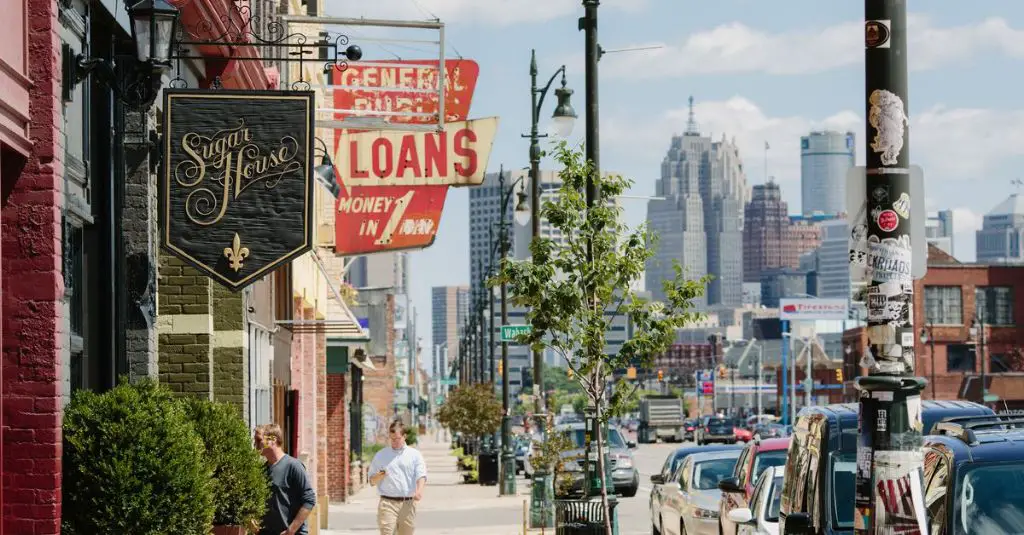Where Is The Best Place To Live In Detroit?
Detroit is a diverse city with many distinct neighborhoods, each with their own character and appeal. When determining the best place to live in Detroit, important factors include safety, amenities, affordability, culture, and proximity to attractions. The ideal neighborhood has low crime rates, good schools, parks and recreation, diversity, and a sense of community. It provides easy access to jobs, entertainment, arts, and culture. With many redevelopment projects transforming areas across Detroit, exciting neighborhoods continue to emerge.
After assessing Detroit’s neighborhoods across these factors, one stands out as the best overall place to live – Downtown Detroit. As the heart of the city, Downtown offers unparalleled amenities and attractions within a vibrant, walkable area. The neighborhood provides urban living at its best.
Downtown
Downtown Detroit is the central business district and original city center. Living downtown provides convenient access to amenities like sports arenas, museums, restaurants, and nightlife. According to https://movinmaker.com/living-in-detroit-pros-cons/ – Downtown rent prices are still affordable compared to other major city downtowns.
Some pros of living downtown include:
- Walkable neighborhoods with things to do
- Public transportation access via the QLine streetcar
- Close proximity to employment centers
Some cons of living downtown include:
- Noise from street traffic and events
- Limited green space and parks
- Older housing stock
Popular things to do downtown include catching a Tigers game at Comerica Park, visiting the Detroit Institute of Arts museum, eating at restaurants like Selden Standard or Grey Ghost, and checking out venues like the Fillmore Detroit or Fox Theatre.
Midtown
Midtown is one of the most popular neighborhoods for young professionals and recent college graduates looking to live in Detroit. Located just north of Downtown, Midtown has seen major revitalization and reinvestment over the last decade.
Some of the key pros of living in Midtown include its central location, walkability, diversity, and cultural attractions. As one of the city’s most vibrant areas, Midtown offers great restaurants, bars, coffee shops, museums, galleries, and music venues all within close proximity (Source 1). The neighborhood is very pedestrian and bike friendly.
However, there are some downsides as well. Rent and housing costs have increased sharply in recent years as demand has surged. Parking can also be a challenge for residents. While safety has improved, crime still remains an issue you have to be aware of (Source 2).
The average rent for a 1-bedroom apartment in Midtown is around $1,100. Buying a starter home will cost around $250,000. While more expensive than other parts of Detroit, Midtown remains very reasonably priced compared to most urban neighborhoods (Source 3).
In terms of things to do, Midtown offers the Detroit Institute of Arts, Museum of Contemporary Art Detroit, Fox Theater, Wayne State University campus, plus bars, shops, cafes, and restaurants along Canfield, Second Avenue, and Cass Corridor.
Corktown
Corktown is one of Detroit’s oldest neighborhoods located just west of downtown. Originally settled by Irish immigrants, Corktown gets its name from County Cork in Ireland. Today it’s known for restaurants, bars, breweries, and historic architecture (Source).
Some pros of living in Corktown are its central location, walkability, and restaurant scene. It’s close to downtown but has more of a neighborhood vibe. Housing ranges from lovely restored Victorian homes to new construction lofts. The downside is limited grocery stores and higher housing costs than other areas (Source).

Corktown is very walkable with a walk score of 88. Most errands can be accomplished on foot. The neighborhood is bounded by freeways on some sides which impacts noise. But overall Corktown offers historic charm near the action of downtown (Source).
Mexicantown
Mexicantown, also known as Mexican Village, is a neighborhood on the West side of Detroit bordering Corktown and Southwest Detroit. It’s known for its Hispanic culture, restaurants, bakeries and markets. Mexicantown originated as a predominantly Mexican neighborhood in the 1920s when immigrants from Mexico moved to Detroit.[1] It’s sometimes referred to as Little Mexico.
Some of the cultural highlights of Mexicantown include:
- Restaurants like Taqueria Lupita, Xochimilco, and El Asador Steakhouse offering authentic Mexican cuisine.
- Bakeries like La Jalisciense selling traditional Mexican breads and pastries.
- Mexicantown Mercado – an open-air market selling produce, meat, spices, and more.
- Annual Cinco de Mayo parade and festival.
- Murals and public art celebrating the neighborhood’s culture.
Housing ranges from small early 20th century bungalows and flats to newer townhome developments. According to Niche, the median home value is around $47,000 as of 2019, significantly lower than the metro area average of $156,800.[2] However, housing prices have been steadily increasing as the neighborhood gentrifies.
While Mexicantown has historically suffered from high crime rates like many Detroit neighborhoods, safety has improved in recent years. There are still occasional incidents of burglary and theft, so practicing standard urban precautions is advised.
[1] https://www.reddit.com/r/Detroit/comments/rjh8h/considering_moving_to_southwest_detroit/[2] https://www.niche.com/places-to-live/n/mexicantown-detroit-mi/
Indian Village
Indian Village is a historic neighborhood located on Detroit’s east side along the Detroit River. Founded in the late 1800s, Indian Village is known for its architecturally significant homes built in various styles like Colonial Revival, Tudor Revival, and Arts and Crafts (Indian Village – Detroit, MI).
Some key pros of living in Indian Village are its beautiful historic homes, proximity to Belle Isle and the Detroit River, and its reputation as one of Detroit’s safest neighborhoods. Indian Village also has an active community association that hosts events and helps maintain the neighborhood. However, housing prices in Indian Village tend to be high, with homes often selling for $300,000 to over $1 million (Palmer Woods or Indian Village?? (Detroit, Southfield). Property taxes are also higher compared to other parts of Detroit.
Things to do in Indian Village include admiring the historic architecture by taking a walking tour, visiting the sculpture garden at Grosse Pointe Assembly Church, and exploring nearby Belle Isle for its nature areas, golf course, aquarium and more. The neighborhood is also close to downtown and Midtown, providing easy access to restaurants, museums and sports venues.
Palmer Woods
Palmer Woods is one of Detroit’s most prestigious and historic neighborhoods, located adjacent to the Detroit Golf Club and on the northern border of the University District. It features elegant homes built in the early 20th century in a variety of architectural styles including Tudor Revival, Colonial Revival, Arts & Crafts, and neoclassical.
Some key pros of living in Palmer Woods include its beautiful tree-lined streets, historic charm, proximity to cultural institutions like the Detroit Institute of Arts, and strong neighborhood association and sense of community. However, home prices tend to be high for the area, with the median listing price around $300,000 as of 2018 according to Niche. Crime rates are relatively low but there have been some concerns about burglaries and break-ins.
Overall, Palmer Woods is one of the safest and most prestigious areas to live in Detroit. Its central location, historic architecture, and active neighborhood association make it highly desirable for those who can afford the higher home prices.
Woodbridge
Woodbridge is a historic neighborhood located along the Cass Corridor in central Detroit. Known for its diverse architecture and tree-lined streets, Woodbridge offers a mix of restored Victorian homes, lofts, and apartments (https://www.niche.com/places-to-live/n/woodbridge-detroit-mi/). It’s become one of Detroit’s most desirable and walkable neighborhoods in recent years.
The neighborhood’s proximity to Downtown, Midtown, and Wayne State University make it popular with young professionals and families. Woodbridge is very walkable, with a high “Walk Score” of 79 (https://www.walkscore.com/MI/Detroit/Woodbridge). The neighborhood has many restored mansions and townhouses, along with modern lofts and apartments. Housing demand has risen sharply, with home prices increasing. However, it remains relatively affordable compared to other trendy Detroit neighborhoods.
While rooted in history, Woodbridge has an artsy, progressive vibe. It features several contemporary art galleries, along with restaurants, cafes, and music venues. The neighborhood hosts an annual art fair that takes place along the streets and in lofts and galleries.
Downsides are the relative lack of green space compared to other neighborhoods. And the area still requires revitalization in parts. But the active neighborhood association works hard on improvements. Overall, Woodbridge’s charm, walkability, and diverse community make it one of Detroit’s top neighborhoods (https://www.reddit.com/r/Detroit/comments/7k7a1g/woodbridge/).
Lafayette Park
Lafayette Park is a historic residential development located east of downtown Detroit. It was designed by architect Mies van der Rohe and features townhouses and high-rise apartments surrounded by parks and green space (source).
Some of the key pros of living in Lafayette Park are the beautiful architecture and landscaping, increased security and community feel, and proximity to downtown while still having green space. Some cons are that it’s less lively and active than other neighborhoods, parking can be challenging, and options for shops and restaurants within walking distance are limited (source).
Housing in Lafayette Park consists mainly of condos, townhouses, and apartments. Prices range from around $150,000 for a 1-bedroom condo to over $300,000 for a larger townhouse. Rents for apartments start around $800/month (source).
Things to do in Lafayette Park include enjoying the walking paths, lakes, and green spaces spread throughout the neighborhood. There are also community events and summer concerts held in the main plaza. The Eastern Market and various downtown attractions are a short drive away.
Conclusion
There are many great neighborhoods to consider when looking for the best place to live in Detroit. Each neighborhood has its own unique character, amenities, and sense of community.
Downtown offers convenience and walkability with access to sports arenas, theaters, restaurants, and the Detroit Riverfront. Midtown appeals to young professionals and creatives with its art galleries, music venues, and proximity to cultural institutions. Corktown is historic and hip with local businesses, breweries, and trendy housing. Mexicantown celebrates Latino culture through authentic food, events, and family-owned shops.
Indian Village provides seclusion and charm with historic mansions and landscaping. Palmer Woods exudes affluence and beauty with grand homes and tree-lined streets. Woodbridge charms with historic architecture and community activism. Lafayette Park was the first successful urban renewal project with modernist architecture and green spaces.
In determining the best Detroit neighborhood for you, consider your lifestyle, interests, budget, and values. Young professionals may thrive in walkable Midtown while families gravitate to the schools and homes of Palmer Woods. Overall, Detroit offers diverse neighborhoods where each person can find their ideal community.



